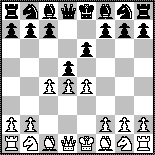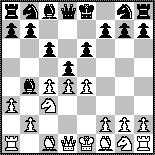DDG
Declined
After 1.e4 e6 2.d4 d5 3.c4, Black can also decline the sacrifice. Many
players hesitate to accept a gambit they have not met before; besides,
there are solid alternatives for Black to transpose to the QGD.
In any case, White has no difficulties in the DDG Declined.
Only about 10 % of my DDGs have been declined, but lately especially
3...c6 has been popular.
B

|
- 3...c6 (Semi-Slav)
- 3...c5 (Tarrasch Defence)
- 3...Nf6
- 3...dxc4 (Queen's Gambit Accepted)
|
3...c6 is a typical way to avoid risks, an attempt to transpose
to a solid and well-known opening. Incidentally, 1.e4 c6 2.d4 d5 3.c4
is called the Caro-Kann DDG. Both e6 and c6 being played, thus
combining the two DDG openings, this variation could be called the
Double(-edged) DDG.
4.Nc3 transposes to the Semi-Slav, Marshall Gambit:
1.d4 d5 2.c4 e6 3.Nc3 c6 4.e4.
A) 4...Bb4 5.Qb3! is nowadays my favorite variation, covered in
Heikkinen - Kaiju, 2000.
5.a3 is the old favorite.
B

- 5...Bxc3+ 6.bxc3 Nf6
(6...Nd7 7.Qg4 g6 8.e5 b6 9.Bg5 Ne7 10.h4 Bb7 11.h5 c5 12.hxg6
hxg6?? 13.Rxh8+ Nf8 14.Bh6 1-0,
Heikkinen - rachelle, Zone 1996)
- 7.f3 Qa5 8.Qb3 Nfd7 9.Bd3 O-O 10.Nh3 Nb6 11.c5 N6d7 12.O-O f6
13.exd5, 1-0 in 27,
Heikkinen - huling, Zone 1996.
- 7.e5 Ne4 8.Qc2 f6 9.f3 Ng5 10.Bd3 fxe5 11.h4 Nf7 12.Bxh7 exd4
13.Bg6 Qe7 14.Bg5 Qf8 15.cxd4 Nd7 16.cxd5 exd5 17.Qe2+ Ne5
18.Qxe5+ Kd7 19.Bf5# 1-0,
Heikkinen - rcraig, Zone 1996.
- 5...Ba5 6.b4 Bc7
- 7.Nf3 dxe4 8.Nxe4 Nd7 9.Bg5 Ngf6 10.Bd3 h6 11.Bh4 O-O 12.Bc2
Qe8 13.Qd3 Nxe4 14.Qxe4 g6 15.Ne5 Nxe5 16.dxe5 Bd8 17.Bf6 Bxf6
18.exf6 Qd8 19.Qf4 Kh7 20.h4 e5 21.Qf3 Re8 22.h5 e4 23.hxg6+
fxg6 24.Qf4 h5 25.Qg5 Qd4 26.Rxh5+ gxh5 27.Qg7# 1-0,
Heikkinen - Väätäinen, 1993.
- 7.e5 Nh6 8.c5 Nf5 9.Nf3 f6 10.exf6 Qxf6 11.Bg5 Qg6 12.h4 b6
13.h5 Qf7 14.Ne5, 1-0 in 27,
Heikkinen - Anonymous, Zone 1996.
- 7.Qg4 Qf6 8.exd5 h5 9.Qe4 cxd5 10.Nxd5 Qd8 11.Nxc7+ Qxc7 12.Bf4
Nf6 13.Qxe6+ +-, Heikkinen - Brown, Zone 1996.
5.f3 provokes Black to take the e4-pawn. 5...Bxc3+ 6.bxc3 dxe4
7.Qc2 exf3 8.Nxf3 Nf6 9.Bd3 O-O 10.O-O Re8 11.Bg5 Nbd7 12.Ne5 Nxe5
13.dxe5 Qb6+ 14.Kh1 Ng4 15.Bxh7+ Kh8 (15...Kf8 16.Qd1) 16.Qe2 g6
17.Qxg4 Kxh7 18.Qh4+ Kg8 19.Bf6 1-0,
Heikkinen - Davis, Zone 1996.
B) 4...dxe4 5.f3 is called the Semi-Slav, Gunderam
Gambit.
Eric Schiller gives the following
assessment in
Unorthodox Openings (1998):
"Another Diemerish Gambit, but this time White has a pawn at c4 and
Black has a bad bishop, which makes this somewhat promising. Yet it
seems to be remarkably easy to equalize as Black."
- 5...e5 6.dxe5 Qxd1+ 7.Nxd1 Nd7 (7...Bb4+ 8.Nc3 Bxc3+ 9.bxc3 Bf5
should be at least equality for Black) 8.fxe4 Nxe5 9.Nf3 Bd6 10.Bd2
Be6 11.Bc3 f6 12.Ne3 Ne7 13.Nd4 Bd7 14.Be2 O-O 15.O-O-O Rfd8 provided
equal chances, Sandmeier - Buerkle, Germany 1980.
- 5...exf3 6.Nxf3 Be7
(6...Nf6 transposes to the DDG
Exchange Variation)
7.Bd3 h6 8.O-O Nd7 9.Bf4 Ngf6 10.Bc2 O-O 11.Qd3 Qe8 12.Ne5 c5
13.Nxd7 Qxd7 14.Be5 cxd4 15.Rxf6 Bxf6 16.Qh7# 1-0,
Heikkinen - Koh, Zone 1996.
- 5...Bb4 6.a3 Bxc3+ 7.bxc3 c5 loses a tempo compared to the
Old Main Line, but Black can take
advantage of the fact that he has not yet played Nf6: White's fxe4 is
effectively prevented. This fantasy variation could continue
8.d5 b5!? 9.cxb5 exd5 10.fxe4 Qh4+ 11.g3 Qxe4+ 12.Qe2 Qxe2+
(12...f5? 13.Bg2 Qxe2+ 14.Nxe2 +/= wins the d-pawn after Nf4 and
c4) 13.Nxe2 Be6 14.Bg2 Nd7 =/+.
5.Nxe4 is part of the established QGD theory, e.g., 5...Bb4+ 6.Bd2
Qxd4 7.Bxb4 Qxe4+ 8.Be2 Na6 (8...c5) 9.Bf8! [Pedersen].
C) 4...Nf6 5.Bg5 Nbd7 6.Nf3 transposes to the
Alekhine Variation of the QGD: 1.d4 d5 2.c4 e6 3.Nc3 Nf6
4.Bg5 Nbd7 5.Nf3 c6 6.e4.
5...Be7 6.f3!? Nxe4 7.fxe4 Bxg5 8.Nf3 dxe4 9.Nxe4 Bf6 10.g4 g6
11.g5 Bg7 12.h4 h5 13.Bh3 Qa5+ 14.Kf2 Nd7 15.Nd6+, 1-0 in 32,
Heikkinen - fregat, Zone 1996.
3...c5 (Tarrasch Defence)
The meanest way to decline a gambit is to play counter-gambit.
Therefore, 3...c5!? is psychologically worthy of
consideration.
This eccentric position is similar to the Austrian Defence 1.d4
d5 2.c4 c5!?.
Very open games are reached after 4.cxd5 exd5 5.dxc5 Bxc5
(5...d4 6.Bc4 Qa5+ 7.Bd2 Qxc5 8.Qb3 Qc7 9.Ne2 Bc5 10.O-O Nc6
11.Na3 with slight advantage for White
[Schwarz])
6.exd5 Nf6
- 7.Nc3 O-O 8.Nf3 Re8+ 9.Be2 Bb4 10.Bg5 Bxc3+ 11.bxc3 Qxd5
12.Bxf6, 1-0 in 38,
Heikkinen - Brown, Zone 1996.
- 7.Bb5+ Bd7 8.Qe2+
(8.Bxd7+ Qxd7 9.Nc3 O-O 10.Nge2 Bb4 11.O-O Bxc3 12.Nxc3 a6
13.Bg5 Qd6 14.Qf3 Nbd7 15.Rad1 h6 16.Bf4 Qb4 17.Rfe1 Qxb2 18.Rb1
Qc2 19.Re2 Qf5 20.Rxb7 Nxd5 21.Nxd5 1-0,
Wall - Grinch, Zone 1996)
Kf8 9.Nc3 Bb4 10.Bc4 Qa5 11.Bd2 Qc5 12.Rd1 h5 13.a3 Bxc3 14.Bxc3
Na6 15.Bxa6 Re8 16.Bb4, 1-0 in 30,
Heikkinen - Brown, Zone 1996.
5.Nc3 would transpose to the Tarrasch Defence, Marshall
Gambit: 1.d4 d5 2.c4 e6 3.Nc3 c5 4.cxd5 exd5 5.e4.
After 5...dxe4, one great line is 6.Bc4
(6.d5 transposes)
- 6...cxd4 7.Qb3!? Qe7 8.Nd5
- 8...Qc5 9.Bf4 Bd6 10.Qb5+ Qxb5 11.Bxb5+ Bd7 12.Bxd6 Bxb5
13.Nc7+ Kd7 14.Nxb5 Nc6 15.Ba3 1-0,
O'Connell - Morris, 1992.
- 8...Qd7 9.Bf4 Bd6 10.Qg3! Bxf4 11.Qxf4 Kd8 12.Qe5! Nc6?
13.Qxg7 Qg4 14.Qf8+ Kd7 15.Qxf7+ Kd8 16.Qc7+ Ke8 17.Qd6! 1-0,
Mah - Vukovic, 1995
 .
.
- 6...Nf6 7.Qb3 Qc7 8.Nb5 Qd7 9.Bf4 Na6 10.O-O-O cxd4 11.Rxd4
Qc6 12.Kb1 Be6 13.Bxe6 fxe6 14.Nd6+ Bxd6 15.Rxd6 Nc5 16.Rxc6 Nxb3
17.Rxe6+ Kf7 18.Rxf6+ gxf6 19.axb3, 1-0 in 46,
Heikkinen - kyros, Zone 1996.
- 6...Qxd4?! 7.Qb3
- 7...Qf6 8.Nxe4 Qe7 9.Be3! Qxe4 10.Bxf7+ +/-.
- 7...Qd7 8.Bf4 Qf5 9.Nge2 (with the idea O-O-O, g4) +/=.
- 7...Be6 8.Bxe6 fxe6 9.Qxe6+ Be7 (9...Ne7 10.Nxe4) 10.Qc8+ Qd8
11.Qxb7 Nd7 12.Qxe4 +/-.
5...Nf6 6.Bg5 transposes to 1.d4 d5 2.c4 e6 3.Nc3 Nf6
4.Bg5 c5 (Dutch-Peruvian Gambit) 5.cxd5 exd5 6.e4!?, which
would leave White with a clear edge
[Pedersen].
4...cxd4 could transpose to the Hennig-Schara
Gambit: 1.d4 d5 2.c4 e6 3.Nc3 c5 4.cxd5 cxd4.
One classic is 5.Qxd4 Nf6 6.e4 exd5 7.exd5 Be6 8.Bb5+ Bd7 9.d6
Nc6 10.Qd3 Be6 11.Bf4 a6 12.Bxc6+ bxc6 13.Nf3 Qb6 14.O-O Rd8
15.Rfe1 Nh5 16.Rad1 Qb7 17.Be5 Nf6 18.Bxf6 Rxd6 19.Nd4 gxf6
20.Ne4 c5 21.Nxd6+ Bxd6 22.Nxe6 1-0,
Marshall - Howard, 1904.
The Nimzo-Indian Defence can transpose to this variation:
1.d4 Nf6 2.c4 e6 3.f3 Bb4+ 4.Bd2 Be7 5.Nc3 d5 6.e4 c5 7.Be3
cxd4 8.Bxd4 dxe4 9.Bxf6 Bxf6 10.Qxd8+ Bxd8 11.Nxe4 Ba5+, 0-1 in 31,
Tyvijärvi - Sarsa, 1991.
3...Nf6 was suggested by the Chessmaster 3000, when modified to
play as an attacker.
A) 4.Nc3 Nxe4
(4...Bb4 5.a3 Be7 transposes to the Nimzo-Indian Defence;
e.g., 6.e5 Ng8 7.Qg4 g6 8.h4 Bd7 9.Nf3 Nc6 10.h5 Na5 11.Bd3 f5
12.exf6 Nxf6 13.Bxg6+ hxg6 14.Qxg6+ Kf8 15.Bh6+ Rxh6 16.Qxh6+ Kg8
17.Rh3 Bf8 18.Rg3+ Kf7 19.Ne5+ Ke7 20.Rg7+ 1-0,
Benda - Broun, 1952)
5.Nxe4 dxe4 6.f3 Nc6 7.d5 exd5 8.cxd5 Bb4+ 9.Bd2 e3 10.Bxb4 Nxb4
11.Qa4+ Nc6 12.O-O-O Qg5 13.f4 1-0,
Gedult - Sachs, 1950.
The BDG may result in similar positions:
- 1.d4 Nf6 2.Nc3 d5 3.e4 Nxe4 (Hübsch Gambit) 4.Nxe4 dxe4
5.Bf4 (5.c4 e6 would reach the same position as above) e6 6.f3 exf3
7.Nxf3 Be7 8.Bd3 Nd7 9.O-O Nf6 10.Qe1 Bd7 11.Ne5 Bd6? 12.Bg5!
Be7 13.Qh4 Rf8 14.c4, 1-0 in 30,
Kampers - Define, corr. 1956-1957.
- 1.d4 d5 2.e4 dxe4 3.Nc3 Nf6 4.f3 exf3 5.Nxf3 e6 (Euwe
Defence) 6.Bd3 Nc6 7.Bf4 Bd6 8.Qd2 a6 9.a3 Bxf4 10.Qxf4 Nd5
11.Nxd5 Qxd5 12.O-O Qd6 13.Qe3 h6 14.c4 O-O 15.Rad1 b5 16.c5
Qe7? 17.Qe4 1-0,
Rasmussen - Ingred, 1988.
B) 4.e5 is a rude attack, but hardly the best idea.
4...Nfd7 5.f4 could transpose to 1.d4 e6 2.e4 d5 3.Be3 Nf6 4.e5
Nfd7 5.f4 b6?! 6.Nf3 c5 7.c4,
Cody - Diener, Compuserve 1992.
4...Ne4
- 5.Nc3 Nxc3 (5...Bb4 would be troublesome) 6.bxc3 Be7 7.Qg4 O-O
8.Bh6 g6 9.h4 Re8 10.h5 Nd7 11.hxg6 fxg6 12.Bd3 Nf8 13.Bxf8 Rxf8
(13...Bxf8 14.Rxh7) 14.Bxg6 Bg5 15.Rxh7 Rf4 16.Rh8+ Kxh8 (16...Kg7
17.Qxf4!) 17.Qh5+ Kg7 18.Qh7+ Kf8 19.Qh8+ Ke7 20.Qg7+ Rf7 21.Qxf7#
1-0,
Heikkinen - Saarelainen, 1996.
- 5.a3! Nc6 6.Nf3 h6 7.Bd3 Be7 8.O-O O-O 9.Qc2 Bg5 10.Bxe4
dxe4 11.Bxg5 Nxd4 12.Nxd4 Qxg5 13.Qxe4 1-0,
Wall - Roswell, Zone 1996.
C) 4.f3 Nxe4?! (4...dxe4
transposes) 5.fxe4 Qh4+ 6.Kd2 Qxe4 (or maybe 6...Qf2+), but how to
continue attack. Besides, White has the option 6.g3 Qxe4+ 7.Qe2
Qxh1, aiming to trap Black's queen.
Note similarity with the Damiano's Defence: 1.e4 e5 2.Nf3 f6?
3.Nxe5 fxe5 4.Qh5+ g6 5.Qxe5+ Qe7 6.Qxh8 Nf6 7.d3 Kf7 8.Bg5.
D) 4.exd5 exd5 5.Nc3 is the French Defence Exchange
Variation.
3...dxc4 is simply the Queen's Gambit Accepted (QGA), which
is analysed more deeply than any other gambit.
1.d4 d5 2.c4 e6 3.Nc3 dxc4
(not a good way of accepting the gambit, as e4 can follow with good
effect; White gets a much freer game [Spielmann])
4.e4! c5 5.Nf3 cxd4 6.Nxd4 a6 7.Bxc4 Bd7 8.O-O Nc6 9.Nf3! Qc7 10.Qe2
Bd6 11.Rd1 Nge7 12.Be3 Ne5 13.Nxe5 Bxe5 14.g3 Bxc3 15.bxc3 Ng6 16.Bb3
O-O 17.Bd4 b5? 18.Qe3 Bc6 19.h4! Qb7 20.h5 Ne7 21.Bxg7! Kxg7 22.Qg5+
Ng6 23.h6+ 1-0,
Spielmann -
Grünfeld, 1929
 .
.



 .
.
 .
.